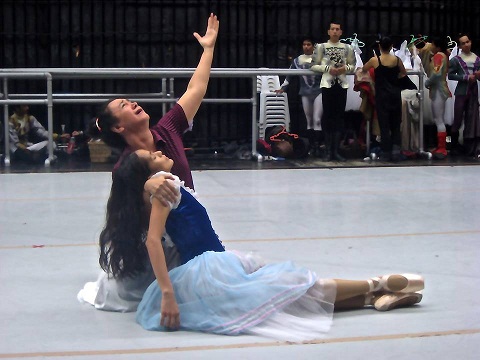By PABLO A. TARIMAN
Photos by EDNA VIDA

Indeed, she has enough resources in her acting arsenal to make the part truly believable. In real life, she is the mother of four, most of them bitten by acting bugs and with least one indie film to their credit.
But one fine day in August, Shamaine found herself accepting the part of a dance heroine in the immortal ballet, Giselle.
On August 16 and 17 at the CCP , she will be transformed as Berthe, the mother of Giselle played alternately by Katherine Trofeo and Carissa Adea.
No, this is not Shamaine’s dance debut. She first ‘danced’ in the Ballet Philippines production of “Noche Buena” and “Isabel” choreographed by Agnes Locsin. She hastens to correct the impression that she has become a character dancer. “I am just an actress doing an acting part in a ballet and I am thrilled to be doing this!”
Truth to tell, the award-winning actress is no stranger to music and dance.
Early in her childhood, her mother enrolled her in piano and ballet classes even before she became a theater scholar in the Philippine High School for the Arts (PHSA).
As a PHSA student in the 80s, she saw Japanese prima ballerina Yoko Morishita dance Odette-Odile in Swan Lake. “I was a mere five feet away from the stage when I saw her dance. Until now, I still remember how her back rippled and how totally in control and passionate she was.”
Her husband — who happens to be another distinguished actor Nonie Buencamino – is naturally pleased. The actor himself appeared in the ballets, “Don Quixote” and in Locsin choreography, “La Revolucion Filipina.” From him, she got inputs on how to tell a story through improvised movements.
In the first rehearsals, she got pointers from danseur Nonoy Froilan who is re-staging the ballet. Trained to act in theater and film, Shamaine finds out acting in ballet is totally different ballgame: she has to act without dialogue and tell a story through movements dictated by the music of Adolph Adams.
First, she has to learn how to count to project different emotions demanded of the role and always with the music in mind. “It’s difficult to count and have acting thoughts at the same time!,” she enthused.
She said she made it a point to ask for the video of Giselle before the first rehearsal to familiarize herself with the movements. “That made the experience less stressful,” she added.
“My first rehearsal was smooth and easy. But I knew while I was doing the steps that I needed to watch the video and listen to the music many times to be able to commit them into memory,” she shared.
Indeed she felt weird not just because she has no dialogue. Acting with a dance ensemble, she felt strange to see a group of dancers extending their arms together to denote that they were talking. And she has to count all over again to express various emotion demanded of the part.
In ballet, joy and grief have limited time frame and always dictated by the music. “When acting for film, one has an inner monologue that fills ones thoughts. Ballet requires precision so one has to think of those counts constantly. It is necessary to listen to the music all the time. In film, it’s your impetus that dictates your rhythm. In ballet, every reaction is measured against the music,” said Shamaine.
“ Also the size: your thoughts can be read by the camera so you don’t have to project. In dance, your thoughts have to be magnified all the way to the tips of your fingers so it can reach the audience sitting at the last row of the balcony in the main theater,” she added.
Before accepting the part in Giselle, she has just wrapped a role in the teleserye, “May Isang Pangarap, ” another stage challenge in PETA’s “Kambal ng Boac” and three indie films. “Instant Mommy,” “David F.” and “Barber’s Tale” due in September.
On the other hand, she is mulling a school-touring theater project with her actor-husband: “We hope to do our civic work through back-to-back monologues of Paciano, Rizal’s brother, and Josephine Bracken, his partner, to students and hopefully instill some values in the process.”
Back to her Giselle part, she points out she is not the first to take a crack in the ballet role. Before her, actors Baby Barredo and Gigi Duenas did the ballet roles as well.
Over the years, she now has a clear idea of what constitutes acting that works.
She concludes: “Truth works all the time. A good actor is one that is devoted to the task of being truthful every time he moves, speaks or thinks, while doing a role. I always tell my children they are only good as their last performance. What do I enjoy in acting? It’s hard to pinpoint. You are drawn to it for many reasons. But I guess what I enjoy in it is the supreme challenge of creating a soul.”